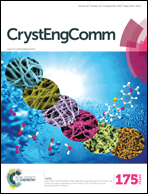Growth of l-arginine phosphate monohydrate crystals in different orientations to achieve isometric morphology for device applications
Abstract
The effect of seed orientation on the growth rate and aspect ratio of LAP crystals was studied using four different seed orientations, namely (100), (010), (001) and (011), with the aim of achieving the isometric morphology required for device applications. For each experiment the growth rates along the principal crystallographic axes and the aspect ratio of the crystal were quantified. It was found that the growth rate was highest along the b-axis for all the seed orientations investigated and followed the trend Rb > Rc > Ra, which is explained on the basis of low bond strength between the (100) cleavage planes and the relative step energies along the b- and c-axis. The aspect ratio of the crystal grown using (011) oriented seed results in a nearly isometric shape. The structural and optical quality of the (011) oriented crystal was investigated using several optical and X-ray techniques. The optical transmittance was ∼88% for 1064 nm and its 2nd (532 nm) and 3rd (355 nm) harmonics, indicating the usability of the material for frequency conversion applications. The band gap of the materials obtained from the UV cutoff was 5.4 eV. Birefringence interferometry and Mach–Zehnder interferometry showed that the refractive index homogeneity of the crystal is very good. The LDT values (4.8 to 6.6 GW cm−2) show that the crystal is suitable for high-power laser applications. X-ray diffraction topography was used for mapping the defect structure of the crystal and the results were correlated with optical microscopy studies. The above characterizations show that (011) oriented LAP crystal has good optical and structural quality and is suitable for device applications.



 Please wait while we load your content...
Please wait while we load your content...